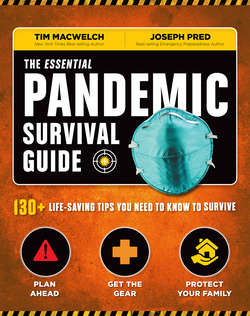Читать книгу The Essential Pandemic Survival Guide - Tim MacWelch - Страница 25
На сайте Литреса книга снята с продажи.
Оглавление20LEARN FROM HISTORY
21
If you’re been paying attention, you’ve been seeing warnings about the mighty power of tiny germs for years—and now, sadly, those warnings are proving true. Yes, this is a serious illness we are facing, but I’d encourage you to look for the “silver lining” in this pandemic—it could have been a much nastier bug. Covid-19 is a horrible disease, and it may take some of our loved ones away from us before this pandemic is over. This situation, however, could have easily been a bio-weapon attack (like smallpox released in every major city) or the natural spread of a more deadly disease (like Ebola or Marberg hemorrhagic fever). Here’s just one example of how it could have been worse. Almost exactly a hundred years ago, the Spanish Influenza pandemic killed somewhere between 40 million and 100 million people worldwide, and infected more than 500 million people across the globe. This especially deadly form of H1N1 influenza virus began killing people in January 1918, and continued until December 1920. Yes, our current situation is scary, it won’t be over soon, and most experts agree that it will get worse before it gets better —nevertheless, count your blessings. This situation could have been so much worse and we could be facing a much deadlier
foe right now.
BLACK DEATHTHE NUMBERS The Black Plague (aka Black Death) hit Europe in 1347, and over the next decade killed between 100
and 200 million people—roughly half Europe’s population.
CAUSE The bacteria Yersinia pestis is believed to be the culprit behind this unprecedented loss of life, hitching a
ride to Europe on flea-infested rats.
SYMPTOMS The plague can manifest in three different ways. Bubonic plague causes swollen lymph nodes throughout the body. Septicemic plague causes bleeding from orifices. Pneumonic plague attacks the lungs and is the most dangerous plague (as it can easily be spread by coughing). All plague forms present with fever, chills, weakness, and
other flu-like symptoms.
CHANCE OF RECURRENCE Yersinia pestis still exists in nature and still affects thousands of people worldwide, but these days it can be easily treated with antibiotics and this is
unlikely to kill multitudes ever again.
“SPANISH” FLUTHE NUMBERS The influenza pandemic of 1918 (which actually began in Kansas) killed somewhere between 40 million and 100 million people worldwide, and infected
more than 500 million people across the globe.
CAUSE This especially deadly form of H1N1 influenza virus began killing people in January 1918, and continued until
December 1920.
SYMPTOMS This flu had all the typical symptoms (fever, nausea, diarrhea, and body aches) but it also had two unusual aspects, a high mortality rate and the fact that
healthy young adults were the primary fatalities.
CHANCE OF RECURRENCE The countless strains of H1N1 influenza virus are still going strong today and there’s little that modern medicine can do to fight it. An episode like the 1918 flu certainly could recur. In June 2009, a new strain of H1N1 received pandemic status as it spread worldwide, and
killed 17,000 by early 2010.
SMALLPOXTHE NUMBERS Smallpox has killed untold millions of people in the last few millennium, and between 300 million and 500 million people in the 20th Century. Thanks to vaccinations, the last case in the United States happened in
1949, and the last case on earth occurred in Somalia in 1977.
CAUSE Smallpox is a disease caused by either of two viral Variola majorVariola minor.
species,
and
SYMPTOMS The disease begins with fever and vomiting, followed by mouth sores and a unique skin rash, consisting
of fluid-filled bumps that are dented in the center.
CHANCE OF RECURRENCE In 1980, the World Health Assembly declared smallpox eradicated; no cases of naturally occurring smallpox have happened since. Now for the bad news: Samples of smallpox have gone missing from storage over the years, and it’s on the radar as a
possible bioweapon.
Now, to be very clear, we’re not suggesting that you become a paranoid hypochondriac, hiding from the light of day. But as one of the memes that circulated as COVID-19 was starting to hit the U.S. went, “If we act quickly now, and nothing bad happens, we run the terrible danger of looking like fools. If we don’t act, andit is that bad, we risk something much worse.” Err on
the side of caution when the stakes are high.
OVERREACT (A LITTLE)
